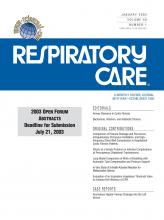Abstract
BACKGROUND: Current American Thoracic Society and American Association for Respiratory Care guidelines for the delivery of aerosol agents such as methacholine chloride (MC) for bronchoprovocation testing require the use of pneumatic jet nebulizers that have well-defined droplet size and mass output. A recently developed disposable, breath-actuated nebulizer (AeroEclipse) may offer bronchoprovocation testers an alternative to existing devices.
METHODS: We studied the performance of 5 AeroEclipse nebulizers with regard to mass of MC delivered with various MC solution concentrations and numbers of inhalations, using a model of adult tidal breathing. Each nebulizer was operated with compressed air (8 L/min at 50 psig) and an initial fill of 2 mL. MC solutions with mass concentrations of 0.25, 0.98, 3.85, and 15.70 mg/mL were tested. The total mass of MC delivered was determined after 5, 10, and 15 complete breathing cycles, by assaying the MC collected on a filter placed at the nebulizer mouthpiece. The aerosol droplet size distribution, fine droplet fraction (FDF) (percentage of droplets < 4.8 μm diameter), and fine droplet mass (FDM) (mass of droplets < 4.8 μm diameter) were determined by laser diffractometry, using physiologically normal saline as a surrogate for MC solution.
RESULTS: The mean ± SD FDM collected in 5 breathing cycles was 654 ± 29 μg with the 15.70 mg/mL solution, 158 ± 9 μg with the 3.85 mg/mL solution, 37 ± 3 μg with the 0.98 mg/mL solution, and 7 ± 2 μg with the 0.25 mg/mL solution. FDM showed a linear correlation (r2 = 0.9999) with MC concentration, within the range studied. FDM also showed a linear correlation (r2 = 0.999) with the number of breathing cycles. For instance, with the 15.70 mg/mL solution, FDM was 654 ± 29 μg with 5 breathing cycles, 1,228 ± 92 μg with 10 breathing cycles, and 1,876 ± 132 μg with 15 breathing cycles.
CONCLUSIONS: Although the bronchoprovocation test procedure had to be slightly modified from the guidelines to accommodate the operation of the AeroEclipse's breath-actuation feature, our measurements indicate that a predictable dose of MC, within the useful range for bronchoprovocation testing, can be delivered to an adult patient breathing tidally. The green indicator on the AeroEclipse could be used to coach the patient to inhale for a specific period, thereby controlling MC delivery per breathing cycle.
Footnotes
- Correspondence: Jolyon P Mitchell PhD C Chem, Medical Aerosol Lab, Trudell Medical International, 725 Third Street, London, Ontario, N5V 5G4, Canada. E-mail: jmitchell{at}trudellmed.com.
All the authors are employees of Trudell Medical International, manufacturer of the AeroEclipse, through its wholly owned United States subsidiary, Monaghan Medical Corporation.
- Copyright © 2003 by Daedalus Enterprises Inc.







